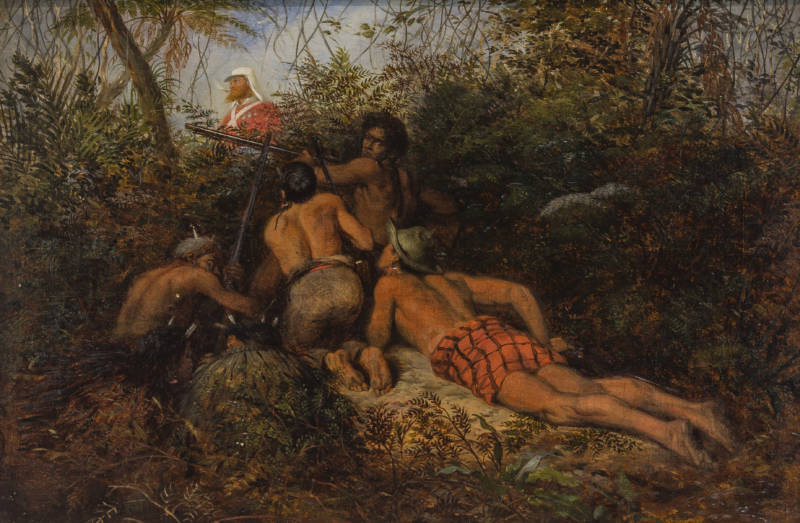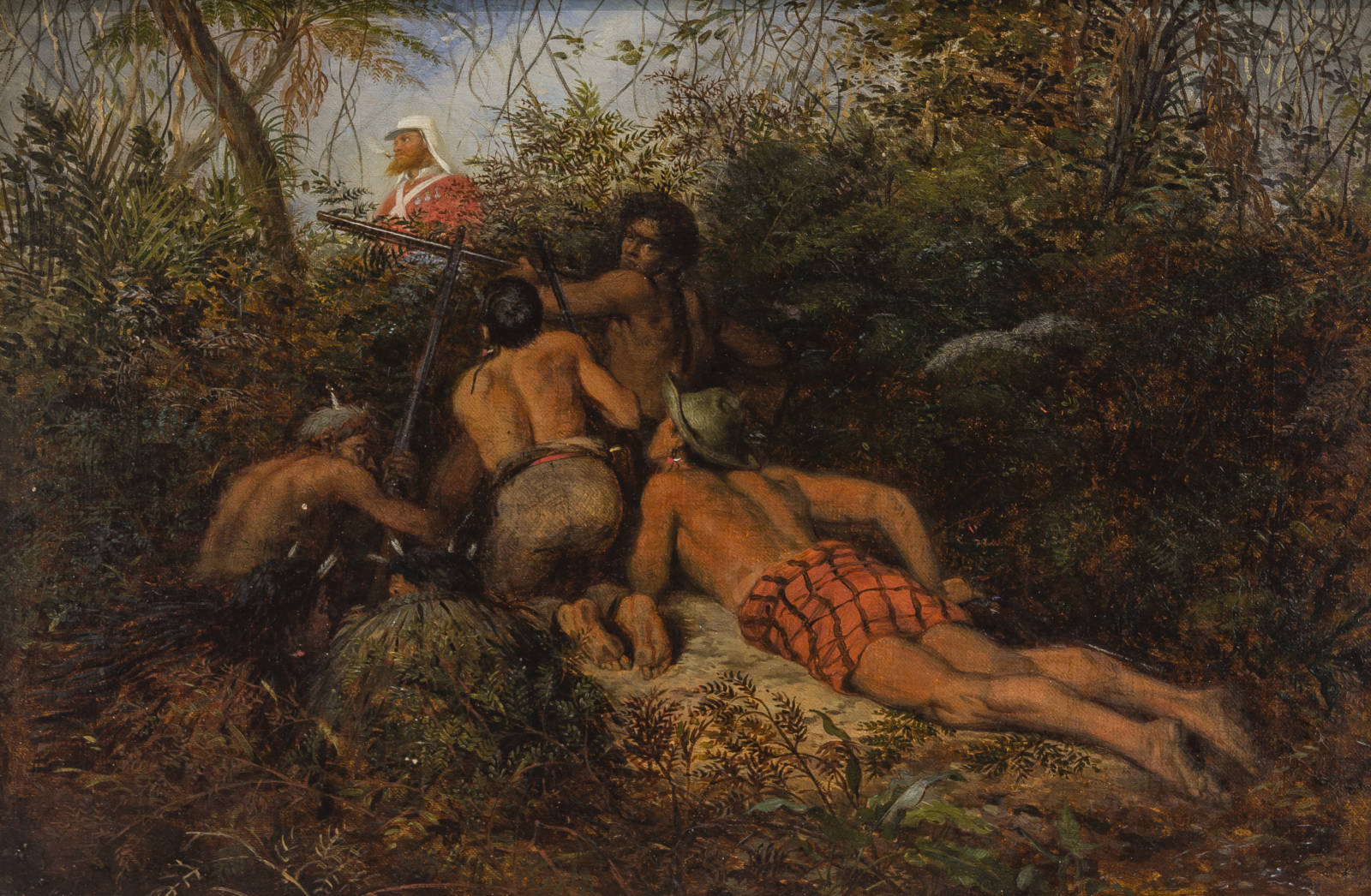STRUTT, William;
The Ambuscade
1867
Oil on canvas
228 x 442mm

William Strutt scholar Heather Curnow has written:
‘No autobiographical or critical material has come to light concerning this painting. However, it is probably identical with a work titled An Ambush, New Zealand, 1859, which was exhibited with the Society of British Artists in 1867. The painting was purchased at auction in London, incorrectly catalogued as a work by Gottfried Lindauer, but was correctly attributed to William Strutt by Mr Hamish Keith, then Keeper of Paintings at the Auckland City Art Gallery [later Auckland Art Gallery Toi o Tāmaki]. Figure drawings by Strutt in the Mitchell Library, Sydney, and the National Library of Australia, Canberra, support Mr Keith’s attribution.’
The following two texts were written for Te Huringa/Turning Points and reflect the curatorial approach taken for that exhibition.
Peter Shaw
Born in Devon, England, into an artistic family, Strutt had his schooling at Jersey and later in Paris. In 1838, he entered the atelier of Michel-Martin Drolling, a pupil of the great neo-classicist painter Jacques-Louis David. In 1839, Strutt was admitted to the École des Beaux-Arts, where he was attracted by the work of the orientalists and was taught by one of them, Horace Vernet. He disliked England and, in 1850, after various jobs as a copyist, he booked a passage for Melbourne. There, he delighted in the ‘pure and searching light’ and worked as a painter and engraver.
Marrying in 1852, he took his wife and one child to Whakatū Nelson in 1855. He remained in Aotearoa for a year, mostly based in Taranaki, where he purchased a bush property between the Henui and Mangorei Rivers. There, he built a ‘whorry’ (whare). In Ngāmotu New Plymouth, he sketched Māori, mostly ‘the grim old and tattooed specimens’, and also favoured subjects in which those he depicted were involved in some strenuous activity.
The Ambuscade was painted after he had returned to England, its detailed treatment of foliage and triangular arrangement of figures showing evidence of Strutt’s academic training. The central visual point of the painting is the contrast between the brightly lit, unsuspecting British redcoat and the group of fearsome warriors, shrouded in gloom, at whose hands he will shortly meet his fate.
Leonard Bell has suggested that the painting offers a generic, fictitious view, probably made to satisfy a contemporary taste for ambush scenes, though undoubtedly referring in a general way to tensions existing in the Taranaki area.
Jo Diamond
The Ambuscade coincided with a notably bellicose time in the history of Aotearoa’s internal affairs, the Land Wars of the 1860s. The luxury of retrospect permits this picture to be addressed in broader terms than Strutt himself may have ever entertained. No longer, for example, do the symbols of war, including guns and a uniform, engender so dramatically the fear of Māori rebellion that they would have once amongst a more naïve audience. Today, for example, we may question the artist’s motives and how his personal experiences impact upon his painting. The painting may then inspire us further than its superficial references to Māori malevolence would restrict us to.
The representation of Māori males in this work resonates with French Revolutionary art, if not an Italian Renaissance preoccupation with ideal, muscular human form, a comparison noted by Strutt himself. This detailed attention to anatomical form is displayed in highlighted chiaroscuro, so much as almost to distract us away from the story of an imminent altercation. The central section of the painting is therefore a glorified one, prompting speculation about where the artist’s loyalties truly lie. Strutt is well-known for his painted episodes of life in this country in the second half of the 19th century and, unlike other nationalistic chroniclers who succeeded him, this image of ‘fierce Māori warriors’ is unusual.
The Ambuscade is a ‘soft sell’, despite the dramatic flailing of muskets and anxious looks of the potential ambushers contrasted with the seemingly off-guard expression of the red-coated soldier. The cloaked individual in the lower foreground does not fit the ‘fierce’ stereotype and his feathered representation is not only obscured, it is also enigmatic. The integration of his kahu huruhuru (feather cloak) with the surrounding foliage could be interpreted (racial stereotypes notwithstanding) as a comment that Māori people are closer to nature than their European counterparts—yet there is a reticence at work that does not completely condemn this or the other ambushers as totally savage by nature.
Exhibition History
Gathered Voices: Highlights from the Fletcher Trust Collection, The Suter Art Gallery Te Aratoi o Whakatū, Whakatū Nelson, 19 August to 12 November 2023 (toured)
Tirohanga Whānui: Views from the Past, Te Kōngahu Museum of Waitangi, 15 April to 15 September 2017
Te Huringa/Turning Points: Pākehā Colonisation and Māori Empowerment, Sarjeant Gallery Te Whare o Rehua, Whanganui, 8 April to 16 July 2006 (toured)
References
Heather Curnow, The Life and Art of William Strutt, 1825–1915 (Martinborough: Alister Taylor, c. 1980), colour plate 30.
Provenance
2004–
Fletcher Trust Collection, purchased February 2004
–2004
Unknown

